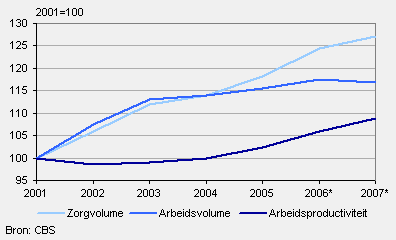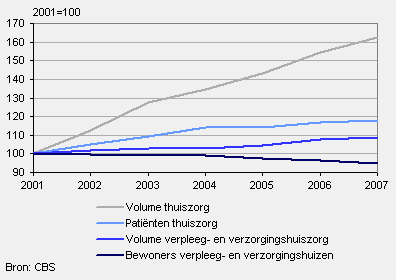More elderly care provided in a more efficient manner

Between 2001 and 2007, labour productivity in the sector elderly care increased by an average of 1.4 percent annually. The labour productivity growth was entirely realised after 2004 when the volume of care provided grew more rapidly than the labour volume. People employed in elderly care did not work longer hours, but the type of care they provided was more complex and demanding.
In the period 2001–2004 care volume and labour volume grew at the same rate
In the period 2001-2004, the growth rate of care volume and labour volume was approximately the same. Hence, labour productivity in elderly care remained more or less stable. The growth in care volume and labour volume in this period is largely attributable to the extra amount of resources used to reduce waiting lists.
Labour productivity in elderly care

More challenging types of care required
After 2004, the care volume grew faster than the labour volume, resulting in a higher labour productivity. The increase in the volume of care provided is not so much caused by an increase in the number of patients or hours of care, but rather by the fact that recipients of elderly care require more ‘challenging’ types of care.
Between 2004 and 2007, for example, the institutional population in nursing homes and elderly homes declined. At the same time, the total volume of care provided grew by an average of 3.4 percent annually. This is predominantly caused by the fact that these institutions provide a large amount of specialist and additional care to clients suffering from diseases like rheumatism, Korsakov’s syndrome or other disorders requiring intensive care.
Care volume and recipients of elderly care

The average annual volume of care per capita provided to recipients of home care has risen even faster (by 5.6 percent) over the period 2004-2007. Overall, home care patients received more hours of care per person and per day and they also required more complex and intensive forms of home care than they did in the past. One of the reasons is that many elderly people prefer to continue living in their own environment for as long as they possibly can.
Jeroen van den Tillaart